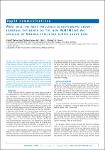What will the next influenza season bring about: seasonal influenza or the new A(H1N1)V? An analysis of German influenza surveillance data
Uphoff, Helmut
Geis, Steffen
Grüber, Andrea
Hauri, Anja M.
For the next influenza season (winter 2009-10) the relative contributions to virus circulation and influenza-associated morbidity of the seasonal influenza viruses A(H3N2), A(H1N1) and B, and the new influenza A(H1N1)v are still unknown. We estimated the chances of seasonal influenza to circulate during the upcoming season using data of the German influenza sentinel scheme from 1992 to 2009. We calculated type and subtype-specific indices for past exposure and the corresponding morbidity indices for each season. For the upcoming season 2009-10 our model suggests that it is unlikely that influenza A(H3N2) will circulate with more than a low intensity, seasonal A(H1N1) with more than a low to moderate intensity, and influenza B with more than a low to median intensity. The probability of a competitive circulation of seasonal influenza A with the new A(H1N1)v is low, increasing the chance for the latter to dominate the next influenza season in Germany.
Dateien zu dieser Publikation
Keine Lizenzangabe
Verwandte Publikationen
Anzeige der Publikationen mit ähnlichem Titel, Autor, Urheber und Thema.
-
2016-02-18ZeitschriftenartikelVaccine effectiveness in preventing laboratory-confirmed influenza in primary care patients in a season of co-circulation of influenza A(H1N1)pdm09, B and drifted A(H3N2), I-MOVE Multicentre Case–Control Study, Europe 2014/15 Valenciano, Marta; Kissling, Esther; Reuss, Annicka; Rizzo, C.; Gherasim, A.; Horváth, Judit K.; Domegan, L.; Pitigoi, Daniela; Machado, Ausenda; Bella, A.; Paradowska-Stankiewicz, I.; Larrauri, A.; Ferenczi, A.; O´Donell, Joan; Lazar, M.; Pechirra, P.; Korczyńska, M. R.; Pozo, Francisco; Moren, A.Influenza A(H3N2), A(H1N1)pdm09 and B viruses co-circulated in Europe in 2014/15. We undertook a multicentre case–control study in eight European countries to measure 2014/15 influenza vaccine effectiveness (VE) against ...
-
2016-10-13ZeitschriftenartikelImproving influenza virological surveillance in Europe: strain-based reporting of antigenic and genetic characterisation data, 11 European countries, influenza season 2013/14 Broberg, E.; Hungnes, Olav; Schweiger, Brunhilde; Prosenc, Katarina; Daniels, R.; Guiomar, R.; Ikonen, N.; Kossyvakis, A.; Pozo, Francisco; Puzelli, S.; Thomas, I.; Waters, A.; Wiman, Å.; Meijer, AdamInfluenza antigenic and genetic characterisation data are crucial for influenza vaccine composition decision making. Previously, aggregate data were reported to the European Centre for Disease Prevention and Control by ...
-
2013-02-14ZeitschriftenartikelEarly estimates of seasonal influenza vaccine effectiveness in Europe: results from the i-move multicentre case–control study, 2012/13 Valenciano, M.; Kissling, E.We conducted a test-negative case–control study based in five European sentinel surveillance networks. The early 2012/13 adjusted influenza vaccine effectiveness was 78.2% (95% CI: 18.0 to 94.2) against influenza B, 62.1% ...

